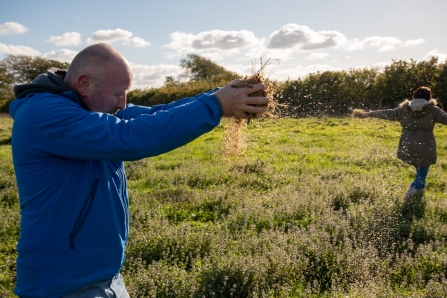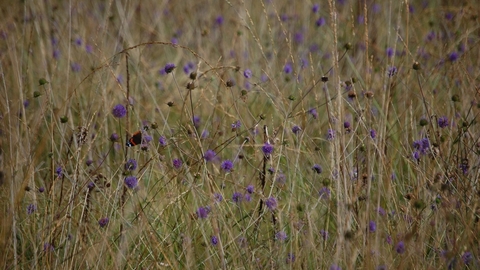Know before you go
Dogs
When to visit
Opening times
Open at all timesBest time to visit
May to SeptemberAbout the reserve
At Devon Wildlife Trust we're very proud of the work we've done over the past 30 years working to preserve the county's Culm grasslands.
Wet and wild they may be, but their wildflower, insect and bird life make them a jewel in Devon's natural riches. Dunsdon shows Culm grassland at its best: it was named Devon's Coronation Meadow in 2012 in recognition of its special value.
Ash dieback
The disease ash dieback is now widespread in the UK and is present at many of our nature reserves, so we carry out tree felling across our sites in winter months. For your own safety please observe temporary path diversions and closures.
Where possible we will leave affected ash trees in place to decay naturally as an important habitat for wildlife. We plan to only fell diseased ash trees which pose a threat to people or infrastructure. Before trees are felled, we will check whether any rare or protected wildlife is present. If it is, we will postpone or avoid felling these trees. No felling will take place during the bird nesting season.
DWT’s Saving Devon’s Treescapes project are working with communities, landowners and businesses to help make Devon's precious treescapes more resilient in the face of ash dieback. Find out how you can get involved here.
NOTICE: If you are visiting our reserves, please note that there have been instances of H5N1 Avian bird flu found in birds in Devon. There is very low risk to public health, but we do ask that if you come across any unusual or unexplained bird deaths on or near our reserves, please do not touch them and avoid allowing your dog to come into contact with dead birds. Please report them to Defra here or call 03459 335577 and also report your findings to DWT by email at contactus@devonwildlifetrust.org.
Contact us
Environmental designation
Location map
Explore Dunsdon nature reserve with Nick Baker (https://www.youtube.com/watch?v=JVdgp9hqes8)
Filmed by the BBC in 2016.

Marsh fritillary. Photo, Chris Root
Big numbers
Dunsdon is probably the best known of our Culm reserves. While, from the 1960s onwards, Culm grasslands disappeared across North Devon, here at Dunsdon the fields of purple moor grass, orchids and butterflies were left unchanged.
Today we continue the traditional management of years gone by - grazing with a few Devon Ruby cattle in summer and swaling (burning) areas in winter. Visit in May to August and the rewards are obvious - 189 species of flowering plant have been counted here including lesser butterfly orchids, petty whin and whorled caraway.
26 different kinds of butterfly have also been spotted, including the unofficial emblem of the Culm - the marsh fritillary.

Petty whin orchid. Photo, Michael Symes
By Royal appointment
In 2012, Dunsdon was named Devon's Coronation Meadow to commemorate the Diamond Jubilee of HRH The Queen. Another recent development has been the purchase of neighbouring fields and the construction of hedgebanks and the planting of wildflowers in an attempt to allow Dunsdon's wildlife to spread.
Dunsdon is also a seed donor site - each year we harvest its wildflower to create new wildflower meadows nearby.
Part of the old Bude Canal which forms the western edge of the reserve has also been recently restored and 're-wetted'. It's now a great place to spot dragonflies and amphibians, while a growing 'herony' is home to several pairs of grey herons.

Sowing seeds at Dunsdon National Nature Reserve. Photo, Ian Threlkeld
More is less
In 2018 one of Dunsdon's rarest species, the lesser butterfly orchid, received a boost.
The orchid was one of 20 threatened plants and animals to be the helped by Back from the Brink - an initiated supported by the Heritage Lottery Fund. The Lesser Butterfly Orchid project was led by our friends at Plantlife and meant that a series of key improvements were made to Dunsdon to help the struggling plant.
These changes included:
- 1.4 hectares of scrub clearance and grassland restoration
- 8.1 hectares of land seeded or receiving transplanted seedlings
- 1,800m2 of experimental seed trial plots developed
In the future we hope to see more of the lesser butterfly orchid's delicate blooms appearing across Dunsdon thanks to this work.
With help from Viridor Credits
In 2017-18 generous support from Viridor Credits Environmental Company paved the way for some big improvements at Dunsdon. These included:
- spreading wildflower seed to enrich parts of the reserve for bees, moths and butterflies
- new gates to provide better access to the reserve
- fencing to allow better use of grazing cattle
- a new bridge to allow people and grazing animals access over a stream to a difficult to get to part of the nature reserve
The creation of Dunsdon’s Coronation Meadow was supported by Biffa Award.
Make the most of your visit
You can begin to explore Dunsdon and the surrounding area using our Dunsdon Wild Walk.
Explore Dunsdon with this download leaflet
Become a member and support our work
The vital work we do for nature depends on the support of people who care about the future of Devon’s wildlife and wild places.





